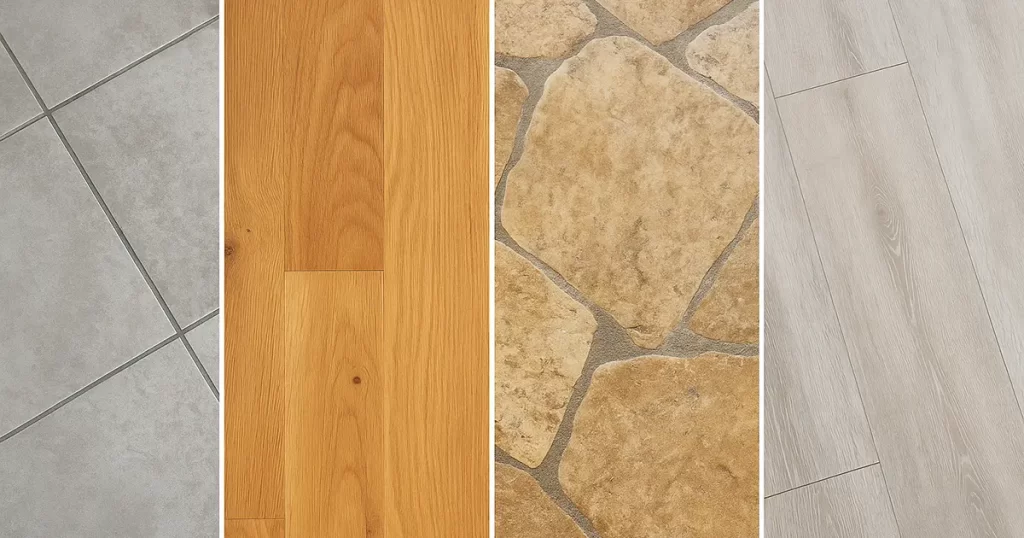
Choosing the best flooring for your kitchen is one of the most important design and practical decisions you can make. The kitchen is the busiest space in most homes. It deals with spills, heavy foot traffic, dropped pans, heat, and constant cleaning. A floor that only looks good but fails under pressure will quickly turn into regret.
As someone who has spent years reviewing flooring materials for real homes, I can tell you that the “best” kitchen floor balances durability, water resistance, comfort, and style. Below, I’ll break down the top options, highlight what really matters, and point out what to avoid.
Kitchen Flooring Options: Quick Comparison
| # | Flooring Type | Why It Works | Best For | Watch Out For |
|---|---|---|---|---|
| 1 | Porcelain / Ceramic Tile | Tough, long-lasting, and highly water resistant. | Homes that need maximum durability and style variety. | Cold and hard underfoot, grout needs sealing. |
| 2 | Luxury Vinyl (LVP/LVT) | Realistic look of wood or stone with waterproof protection. | Busy families and budget-conscious remodels. | Lower resale value, cheaper products can fade or scratch. |
| 3 | Engineered Hardwood | Real wood surface with better stability than solid hardwood. | Homeowners who want wood’s warmth in the kitchen. | Still not waterproof, spills must be cleaned quickly. |
| 4 | Natural Stone | Elegant, unique appearance with excellent long-term durability. | High-end kitchens seeking a timeless look. | Requires sealing, softer stones can stain or scratch. |
| 5 | Concrete | Extremely durable and customizable with stains or polish. | Modern and industrial-style kitchens. | Hard and cold, must be sealed against moisture. |
| 6 | Bamboo | Sustainable and harder than many hardwoods. | Eco-conscious homeowners who want a natural style. | Can scratch, fade in sunlight, and warp with moisture. |
| 7 | Cork | Soft, warm, and comfortable underfoot with natural insulation. | Home cooks who spend long hours standing. | Needs resealing, can dent or fade over time. |
| 8 | Laminate | Affordable, easy to install, and resistant to scratches. | DIY projects and quick updates on a budget. | Not waterproof, cannot be refinished. |
| 9 | Linoleum / Marmoleum | Natural, renewable, and long-lasting when sealed. | Eco-friendly kitchens with a classic style. | Can fade in sunlight and absorb spills if unsealed. |
Now let’s look at each flooring type in more detail so you can see which one fits your kitchen best.
Best Type of Flooring for Kitchen
There’s no single “perfect” kitchen floor for every home. The right choice depends on how you use your kitchen, how much maintenance you want to deal with, and the overall look you’re going for.
Below, we break down the top flooring types, explaining what makes each one a smart option and what to consider before you decide.
1. Porcelain and Ceramic Tile
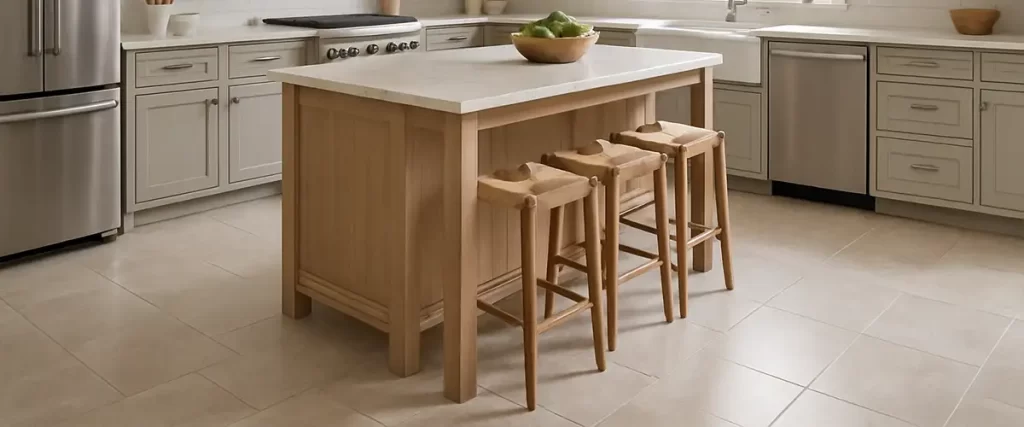
Tile is one of the best types of flooring for kitchens because it combines strength with water resistance. Kitchens deal with spills, heat, and heavy use, and porcelain or ceramic tiles can handle all of that without losing their appearance.
Porcelain is denser and less porous than ceramic, which makes it more resistant to stains and moisture. Ceramic, on the other hand, is easier on the budget while still holding up well in everyday use.
Another advantage of tile is the design flexibility. It comes in endless patterns, colors, and sizes, making it easy to match any kitchen style. Large tiles reduce grout lines, giving a clean, modern look.
The tradeoff is comfort. Tile can feel cold and hard underfoot, and grout lines need proper sealing to prevent stains. Still, if durability and water resistance are top priorities, porcelain or ceramic tile is one of the safest choices you can make for a kitchen floor.
2. Luxury Vinyl
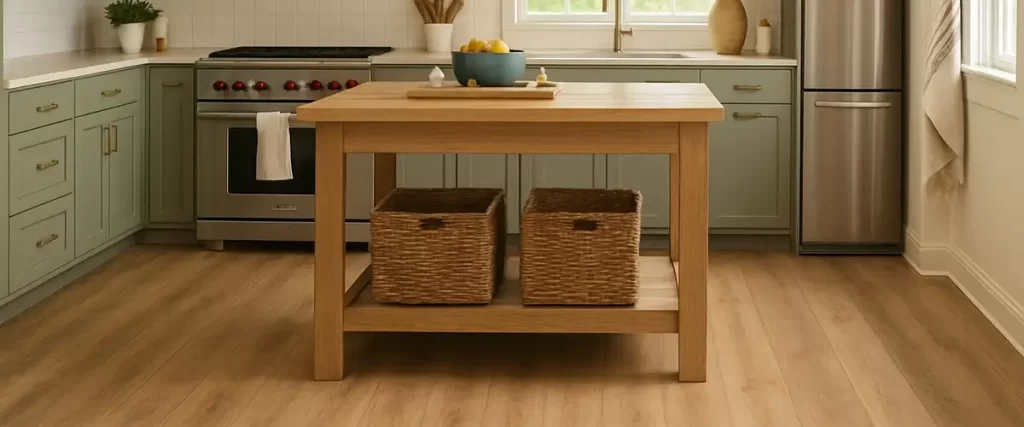
Luxury vinyl plank (LVP) and luxury vinyl tile (LVT) have become some of the most popular kitchen flooring options in recent years. The main reason is simple: they combine realistic looks with practical performance.
Vinyl can mimic the appearance of wood, stone, or tile so well that most people won’t notice the difference at first glance. At the same time, it’s waterproof, scratch resistant, and softer underfoot than ceramic or stone, which makes long hours in the kitchen more comfortable.
Homeowners also appreciate how easy it is to install. Many vinyl products come with click-and-lock systems that make them a true DIY option. Maintenance is simple as well, requiring just sweeping and an occasional mop.
The downsides are mostly about perception. Vinyl does not add as much resale value as natural wood or stone, and lower-quality products can fade or scratch more easily. Still, if you want a balance of affordability, comfort, and water resistance, luxury vinyl remains one of the best flooring types for kitchens.
3. Engineered Hardwood

Engineered hardwood gives you the natural warmth of wood while offering better stability than traditional solid hardwood. In a kitchen, where humidity and temperature can fluctuate, that stability makes a big difference.
The surface is real wood, so you still get the authentic look and texture that many homeowners love. Depending on the thickness of the veneer, it can also be refinished to refresh its appearance over time.
Engineered hardwood is easier to install than solid hardwood and can often be floated or glued in place. It also pairs better with underfloor heating systems, which makes it more adaptable to modern kitchen designs.
The biggest drawback is water. Engineered wood handles light moisture better than solid hardwood, but it is still not waterproof. Spills need to be cleaned quickly to avoid swelling or warping. If you want the beauty of wood in your kitchen and are prepared to maintain it carefully, engineered hardwood is a smart choice.
4. Natural Stone
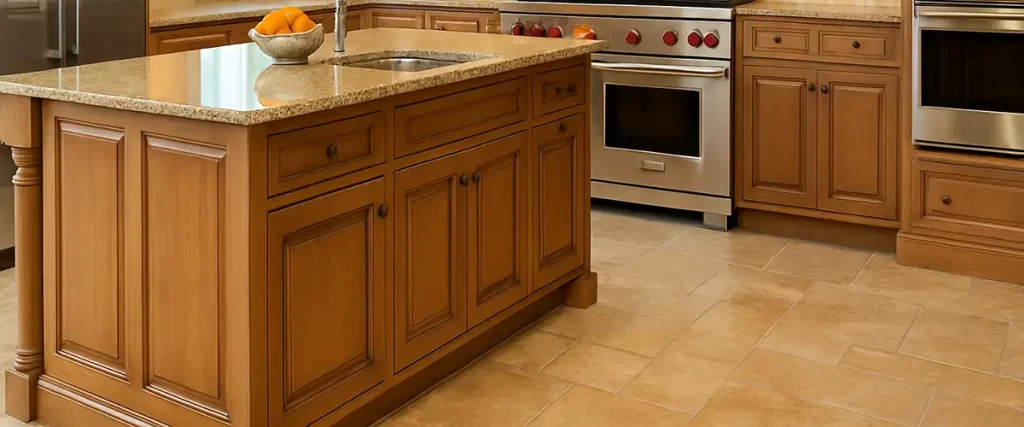
Natural stone instantly gives a kitchen a high-end look. Materials like granite, slate, travertine, and quartzite are known for their strength and unique patterns that no man-made product can fully replicate. With the right choice, a stone floor can last for decades.
Quartzite and granite are the most durable options, resisting scratches and heavy foot traffic. Softer stones like marble and limestone are beautiful but require more care, as they can etch or stain if spills are not cleaned quickly.
Stone floors are also naturally cool, which works well in warmer climates. For homes in colder regions, pairing stone with radiant heating creates both comfort and luxury.
The main considerations are cost and maintenance. Stone is one of the more expensive flooring types, and many varieties need sealing every year or two to protect against stains. If your priority is timeless beauty and long-term durability, natural stone remains one of the best flooring types for kitchens.
5. Concrete
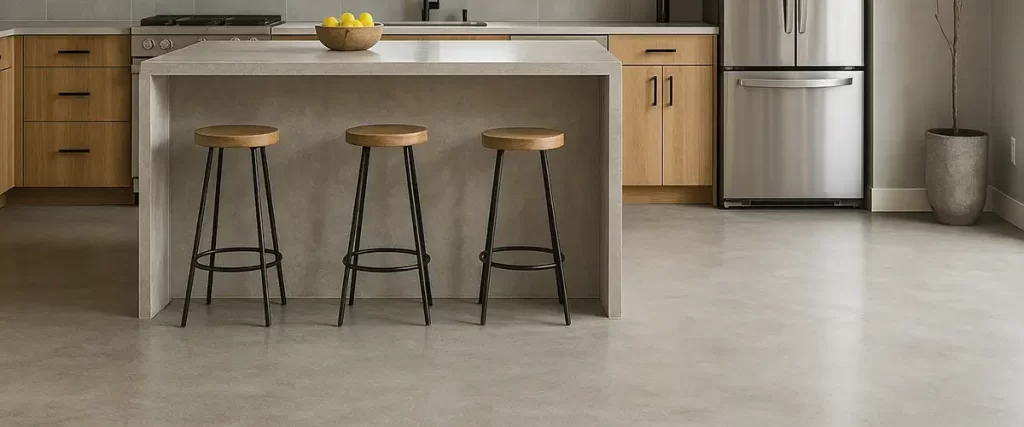
Concrete has moved beyond basements and garages to become a modern flooring option for kitchens. When polished or stained, it delivers a sleek, contemporary look that pairs well with minimalist and industrial-style designs.
One of the biggest advantages is durability. A properly finished concrete floor can last as long as the house itself. It resists heavy traffic, dropped items, and heat without showing much wear. It is also compatible with underfloor heating, which helps balance out its naturally cool surface.
Concrete offers design flexibility too. It can be polished to a shine, stained for rich color, or textured for grip and character. This makes it more versatile than most people realize.
The tradeoffs are comfort and upkeep. Concrete is hard underfoot, and without heating it can feel cold. It also needs sealing to protect against moisture and stains. For homeowners who want a strong, long-lasting, and modern look, concrete is a flooring choice worth considering for the kitchen.
6. Bamboo
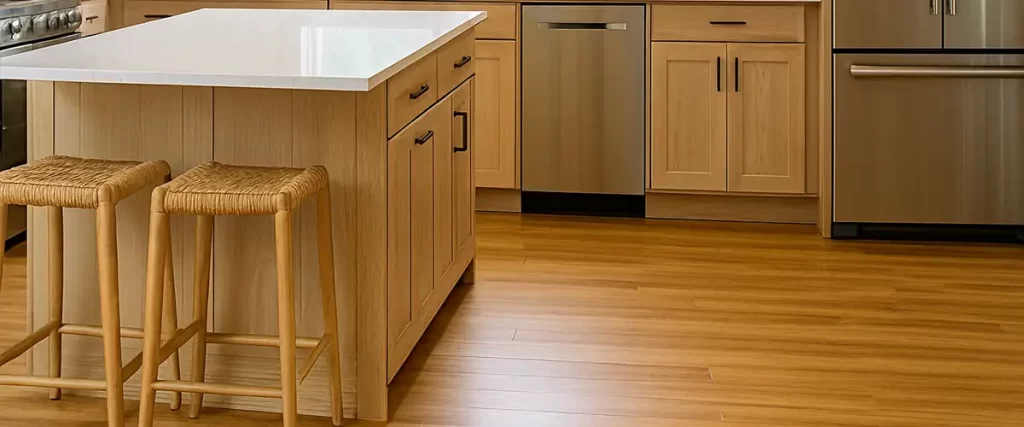
Bamboo has become a popular alternative to traditional hardwood because it offers a similar natural look with stronger eco-friendly credentials. Since bamboo grows quickly and regenerates without replanting, it is considered one of the most sustainable flooring materials available.
Strand-woven bamboo is the most durable option, often harder than oak or maple, and it can handle the heavy traffic of a busy kitchen. Its resistance to moisture is better than solid hardwood, although it is not fully waterproof.
In terms of style, bamboo comes in a range of colors and finishes, from light natural tones to darker carbonized shades. This variety makes it flexible enough to work in both modern and classic kitchen designs.
The downsides are scratching and sunlight exposure. Sharp objects or heavy furniture can leave marks, and direct sunlight may cause fading over time. Still, for homeowners who want a renewable, stylish material that balances durability with sustainability, bamboo remains one of the best flooring types for kitchens.
7. Cork

Cork flooring stands out because of its comfort and eco-friendly qualities. Made from the bark of cork oak trees, it’s a renewable material that doesn’t harm the tree when harvested.
The biggest advantage of cork is comfort underfoot. It has a natural cushioning effect that makes long hours of cooking easier on your legs and back. It also provides insulation, keeping the floor warmer and helping reduce noise in the kitchen.
Cork is resistant to mold, mildew, and pests, which adds to its appeal in a high-moisture environment. With proper sealing, it can handle everyday spills and heavy foot traffic.
The main drawbacks are durability and maintenance. Cork can scratch or dent more easily than harder surfaces, and it needs to be resealed every few years to protect against water damage. For homeowners who value comfort and sustainability, cork is one of the most practical flooring types for kitchens.
8. Laminate
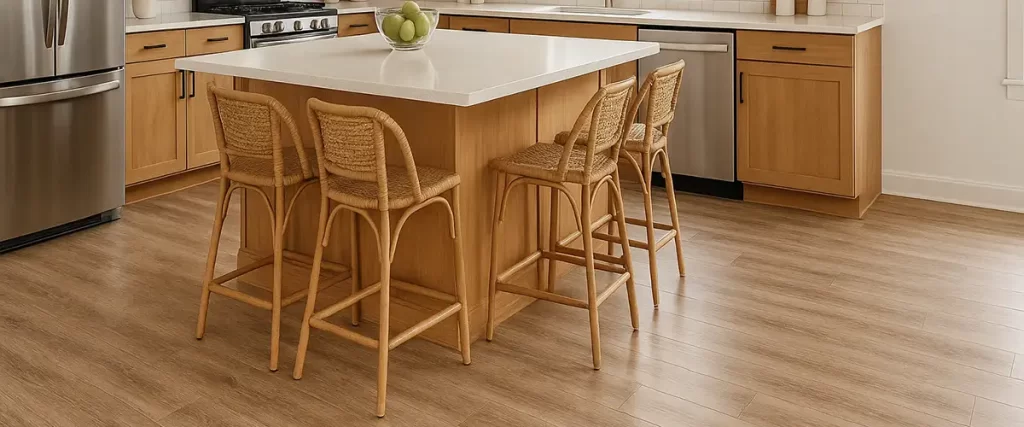
Laminate flooring is often chosen for its affordability and simple installation. Many products use a click-lock system that allows homeowners to put it down without professional help.
The surface layer is designed to mimic wood or tile, giving kitchens an upgraded look at a lower cost. Laminate also resists scratches and stains fairly well, which makes it a practical option for busy households.
The main concern is water. Laminate is not waterproof, and if moisture seeps into the seams it can swell or warp. Even water-resistant varieties have limits, so spills need to be cleaned quickly.
It also cannot be refinished, so damaged boards must be replaced. For homeowners who want a budget-friendly option that looks good and installs quickly, laminate can be a useful choice, but it comes with more tradeoffs than other kitchen flooring types.
9. Linoleum and Marmoleum

Linoleum is a classic material that has regained attention for its eco-friendly qualities. Made from natural ingredients like linseed oil, cork dust, and wood flour, it is sustainable and free from harmful chemicals. Marmoleum is a branded version of linoleum with modern updates in style and durability.
These floors are warm underfoot, quiet to walk on, and available in a wide range of colors and patterns. When properly installed and sealed, they can last for decades with only basic cleaning.
The drawbacks are mostly about care. Linoleum can fade in direct sunlight, and if it isn’t sealed, it may absorb spills and show damage over time. Some products also release a temporary odor after installation, though this fades with ventilation.
For homeowners who want a natural and renewable product that balances cost, comfort, and longevity, linoleum and Marmoleum are strong contenders for kitchen flooring.
Key Things to Look For in Kitchen Flooring
Before jumping into materials, keep these factors in mind. They separate a floor that lasts for decades from one that becomes a maintenance headache.
- Durability: Can it handle drops, scratches, and high traffic?
- Water Resistance: Kitchens mean spills. Waterproof or highly water-resistant flooring is safest.
- Ease of Cleaning: A kitchen floor should be quick to mop and resistant to stains.
- Comfort Underfoot: If you spend hours cooking, a softer or warmer material reduces fatigue.
- Budget: Prices vary wildly, so weigh cost against lifespan.
- Aesthetics: The floor should complement your kitchen’s overall design.
- Resale Value: Quality floors like hardwood, stone, and porcelain tile often boost home value.
- Sustainability: Eco-friendly options like cork, bamboo, and linoleum matter if green living is a priority.
Flooring to Avoid in Kitchens
Some materials just don’t perform well in kitchens:
- Carpet: Holds stains, grease, and odors. Impossible to keep sanitary.
- Softwoods (like pine): Too soft and prone to dents and water damage.
- Unsealed marble, limestone, or sandstone: Too porous for a busy kitchen unless heavily maintained.
FAQs About Kitchen Flooring
What is the most durable flooring for kitchens?
Porcelain tile and luxury vinyl are usually considered the most durable. They handle water, scratches, and heavy traffic extremely well.
Can I install kitchen flooring myself?
Yes, if you choose click-lock vinyl, laminate, or some engineered wood. Tile, stone, and hardwood are better left to professionals.
What is the best flooring for kitchens prone to water spills?
Waterproof vinyl planks or porcelain tile. Both can take standing water without permanent damage.
Are there eco-friendly flooring options?
Yes. Bamboo, cork, and linoleum are all renewable and sustainable.
How do I maintain my kitchen flooring?
Sweep or vacuum daily, mop with mild cleaners, and follow manufacturer guidelines. Tile may need grout cleaning, and hardwood or cork requires refinishing or sealing over time.
Which flooring manufacturers are the most reliable for kitchens?
Some of the most trusted brands include Armstrong Flooring for vinyl and tile, Pergo for laminate, Shaw Floors for stain-resistant designs, Mohawk Industries for eco-friendly options, and Bruce Hardwood Floors for premium hardwood.
Our Recommendation for the Best Kitchen Flooring
If we had to narrow it down, porcelain tile and luxury vinyl plank stand out as the most reliable choices for most kitchens. They combine durability, water resistance, and style in a way that few other materials can match.
For homeowners who value comfort, cork offers a softer feel underfoot, while engineered hardwood brings warmth and elegance if you are prepared to manage moisture carefully.
The key is matching the floor to your lifestyle. Consider how often you cook, how messy your household can get, and how much time you are willing to spend on maintenance. When those factors line up with the right material, your kitchen floor will not only look good but also perform well for decades.
Ready to Upgrade Your Kitchen Flooring?
Choosing the right floor is just one step in creating a kitchen that looks great and works for your lifestyle. Our team has years of experience in kitchen flooring and full kitchen remodeling, and we know how to match the right materials with the right design.
If you’re planning a remodel or simply want new flooring that lasts, we’re here to help with expert guidance and professional installation. Contact us at (254) 369-5978 to get started on your kitchen remodeling project today. Or hit use
